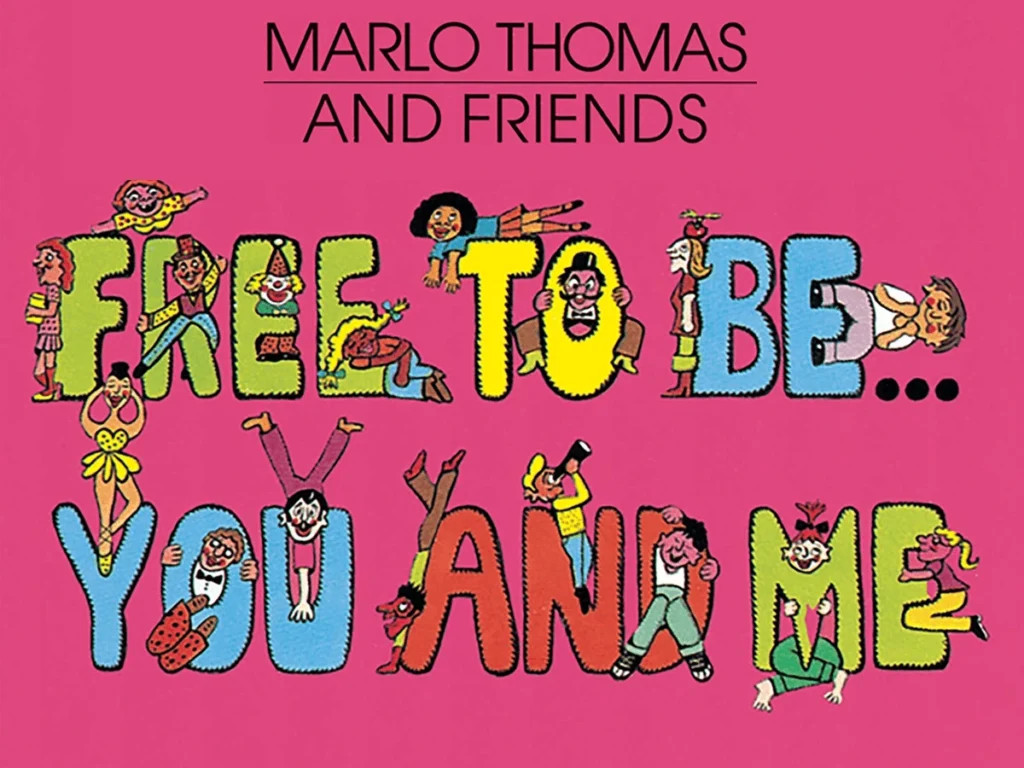When I see the words “Free to Be…” I hear the banjo bum ba da bum bum, that drum, and there’s a land that I see where the children are free…
And I feel good. It’s my childhood. Days of Pete Seeger, Harry Chapin (Kleenex alert on that link), hope and possibility.
My early caregivers played Free to Be You and Me over and over and over again. I can see that hot pink cover in a hot flash — pun intended — as the record and I were both born in 1972.
My mom was one of the only working moms in our neighborhood at that time, so I was often at other kids’ homes. Moms stitched it together. There was always someone to take me in.
When I think Free to Be, my brain and body travel to the homes of the McCarthys or the McClellans, eating liverwurst sandwiches, sitting in wood paneled basements with light blue shag rugs. Carole and Paula, The Magic Garden.
Free to Be You and Me was created by Marlo Thomas, who wanted to teach her young niece that “it is acceptable to refute or reject the gender stereotypes expressed in children’s books,” (according to Wikipedia).
It was an unexpected success. Thomas recalls, “Larry Uttal at Bell Records told me, this kind of record might sell 15,000 copies tops. Well it went Gold right away, went Platinum within two years and went Diamond in under ten years. EVERYBODY was amazed it had touched such a nerve. It’s still in the top 100 albums of all time over 40 years later.” It also became a TV special in 1974.
In 2022 I soaked in all the “fifty years since” history, remembering both how far we’ve come (first issue of Ms. Magazine), and our setbacks (Roe v Wade, which was argued in 1972). But there’s something about Free to Be that impacted me more deeply than the other anniversaries.
It’s music for one, so it’s a full sensory experience that thoughts do not provide.
The promise of Free to Be was an invitation to feel your feelings and be who you want to be. Pro football player Rosey Grier reminding boys and girls that It’s All Right to Cry (it gets the sad out). In William Wants A Doll, a boy has to contend with his friends and parents refusing him the birthday gift he wants. And bless Carol Channing for her spoken word poem on the reality of housework. She confides that the ladies in the commercials are paid to say they enjoy housework, that no one really likes it but we can work together to make the load lighter. (Full lyrics here.)
Social commentary from top to bottom. And of course, Alan Alda, Michael Jackson, Harry Belafonte, Roberta Flack, Shirley Jones, Mel Brooks. All sharing their poems, songs, ideas and stories to help children just be themselves.
The title track invites hope that we can live in a land where the people are free to be whatever and whomever they choose.
No surprise that I love this talk — for the last 20 years I’ve run a coaching practice where I help adults free themselves up to do the work they choose, have the lives they choose. Want to go back to college at 40? Do it! Retire early (or not at all), yes please! Conceive a legacy career at 65? Trade in making more money (that I don’t need) for a better partnership with my spouse? (heck yeah!).
While it’s bittersweet to listen to Free To Be (really, in 50 years, this is the best we can do?) It’s also magnificent to see how many doors were opened decades ago that allowed for the conversations we’re having today.
I’d love to see a new version of the record for those of us who grew up in the 70s and 80s, inviting us to remember who we wanted to be, what we wanted to do, and check in to see how it’s going. Rosey Greer would be game, I just know it.
Everyone can use a little mid-adulthood check in. Consider this yours. After all, parents are people, deserving of all that compassion, kindness and hope too.
With love, affection and joy,
Allison



